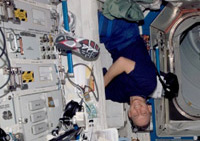|
|
| Space travel can be dizzying |
|
|
Canadian medical experiments study the effects of weightlessness
| During a welcome-home ceremony in Houston, Texas, just after returning from a gruelling 12-day construction mission to the International Space Station in September 2006, astronaut Heidemarie Piper suddenly fainted. Luckily, her crewmates, including Canadian astronaut Steve MacLean, were there to help her recover.
To better understand this phenomenon, a new Canadian medical experiment is now under way. It studies how long periods in space affect the human body and what can be done to better protect space travellers in the future. It could also have everyday medical applications, benefiting elderly people who experience fainting spells or falls, and people who suffer from heart diseases caused by sedentary lifestyles. |
 Astronaut Clayton C. Anderson, Expedition 15 flight engineer at work onboard the International Space Station. (Credit: NASA)
Astronaut Clayton C. Anderson, Expedition 15 flight engineer at work onboard the International Space Station. (Credit: NASA) |
What causes the blackouts?
Dizziness and blackouts are not uncommon amongst returning astronauts. About 20% of Space Shuttle crewmembers and 80% of International Space Station astronauts are affected by light-headedness and fainting upon returning to Earth's gravity. It's not a major concern, but researchers believe that this may have health implications for astronauts readapting to gravity after longer flights on the orbiting station, to the Moon, or even on multiple year missions to Mars.
In the weightlessness of space, the heart doesn't have to work as hard. Without the usual force of gravity, blood tends to accumulate in the head and chest. After a few days the body begins to adapt. The astronauts exercise regularly on the Station so their muscular, skeletal, cardiovascular and other systems stay as fit as possible.
But after the astronauts return to Earth, this adaptation of the cardiovascular system causes blood to collect in their lower body, and so less blood flows to the brain. In some cases, astronauts experience dizziness, while others may faint because not enough oxygen-rich blood reaches the brain.
A promising experiment
The new experiment is led by University of Waterloo researcher Richard Hughson and sponsored by the Canadian Space Agency. The CCISS experiment (for "Cardiovascular and Cerebrovascular Control on Return from the International Space Station") is the first to try to look fully at how astronauts' bodies cope with microgravity over many months on the Space Station.
Hughson and his team believe that these experiments can go beyond helping future space travellers who embark on long space missions. The unique archive and some of what is learned about how astronauts maintain their health in space may have down-to-Earth benefits that could help the elderly and people with cardiovascular health problems.
Astronauts are committed to taking part
There are experiment sessions before, during, and after the space flight. Prior to the mission, baseline measurements are taken to monitor blood flow of six crewmembers. Then, in the early and late portions of their four- to six-month flights, over 24-hour periods, the astronauts take readings of their heart rate and blood pressure during normal activities.
Recently, Expedition 15 crewmember and NASA astronaut Clay Anderson conducted this part of the experiment in space. On October 21, 2007, Anderson measured his heart rate, blood pressure, and body movements over a 24-hour period using three portable devices. He then sent the readings back to NASA's Marshall Space Flight Center in Huntsville, Alabama. The experiment continued with NASA astronaut Dan Tani on mission STS-120, which launched on October 23, 2007.
|
